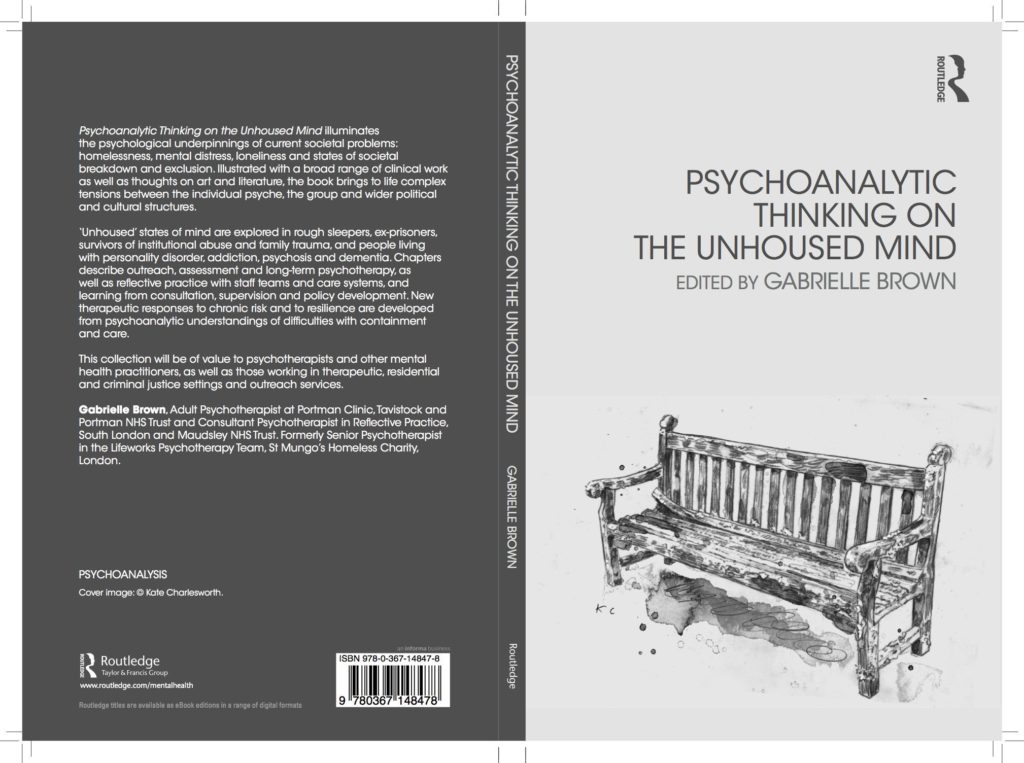‘Narratives of the Therapeutic Encounter’

SAPP member Dr Susan Bainbrigge is one of the editors of and contributors to this book.
This collection of essays combines the analysis of psychoanalytic and fictional texts to explore the implications that arise from the space between the participants in therapy, including creative and aesthetic inspirations, therapeutic potentials, and ethical dilemmas.
Click here for more information on the book.
‘Psychoanalytic Thinking on the Unhoused Mind’
Containing two chapters by SAPP member, June M Campbell; and edited by Gabrielle Brown, this book creatively brings psychoanalytic thinking to bear on societal problems such as homelessness, alienation and institutional abuse.
This book has been nominated for the Gradiva Award from the National Association for the Advancement of Psychoanalysis.
It is named as second of Brett Kahr’s top ten psychoanalytic books of 2019. Click here to read the review.
A review of the book by Angela Foster appears online in the journal ‘Psychoanalytic Psychotherapy’. Click here to read her review.
Click here for more information on the book.
‘Making Spaces: Putting Psychoanalytic Thinking to Work’
SAPP member Molly Ludlam is one of the editors of this book, which argues for the value and application of psychoanalytic thinking beyond, as well as within, the consulting room. Inspired by a Scottish psychoanalytic tradition that owes much to W.R.D. Fairbairn and J.D. Sutherland, the Scottish Institute of Human Relations has provided a valuable reference point for the work described in the book. It illustrates how the coming together of human beings into a shared space fosters opportunities to create loving, collaborative relationships in which to work and from which to grow.
Click here for more information.
‘Couple Attachments: Theoretical and Clinical Studies’
SAPP member Molly Ludlam is one of the two editors of this book. The couple relationship is at the centre of this book. The complex nature of the couple attachment is emphasized, drawing both on psychoanalytic concepts and on attachment theory. The chapters aim to integrate theory with practice and can be seen, both separately and together, as offering new insights into the intricate web of psychic fantasies, shared unconscious anxieties and external realities that shape the attachment between the couple.
Click here for more information.
Other publications by SAPP member Molly Ludlam
2018: Couples Come in Twos and Threes: an Oedipal Perspective
In: A.Novakovic & M.Reid (Eds.), Couple Stories (pp 135-140). London: Taylor & Francis.
2016: Do Ronald Fairbairn’s Ideas Still Speak Usefully to 21st Century Couple Therapists?
fort da, XXII, (2), 12-26.
2014: The Perinatally Depressed Couple and the Work of Mourning: a Development Imperative
In: K.Cullen, E.Bondi, J.Fewell, E.Francis, & M.Ludlam,
Making Spaces: Putting Psychoanalytic Thinking to Work, (pp. 109-125), London, Karnac.
2014: Sitting with Marital Tensions: The Work of Henry Dicks in Applying Fairbairn’s Ideas to Couple Relationships
In: G.S.Clarke &D.E.Scharff (Eds.), (pp. 175-184),
Fairbairn and the Object Relations Tradition. London, Karnac.
2014: Failure in Couple Relationships – and in Couple Psychotherapy
In: B.Willock, R.Coleman Curtis, & L.C.Bohm (Eds.).
Understanding and Coping with Failure: Psychoanalytic Perspectives, (pp. 65-71). London and New York: Routledge.
2011 – 2019: Editor – Couple and Family Psychoanalysis. Vols 1-IX
London: Karnac.
2008: “The Longing to Become a Family”, and (with F.Calvocoressi) “Shared Reflections on Parallel Collaborative Work with Adoptive Families”.
In: D.Hindle & G>Shulman (Eds.), The Emotional Experience of Adoption
(pp. 177-191). London & New York: Routledge.
2006: Psychotherapy for the Parents as a Couple
In: D.E.Scharff & J.Savege Scharff (Eds.),
New Paradigm for Treating Relationships, (pp 87-98).
Lanham M.D.: Jason Aronson
2005: The Parental Couple: Issues for Psychotherapeutic Practice,
Sexual and Relationship Therapy, 20 (3): 323-332
Publications by non-SAPP members that might be of interest
Below is an overview of the key writings of and about Ronald Fairbairn (1889 – 1964), Scottish psychoanalyst and psychiatrist, who was a central figure in the development of object relations theory.
Fairbairn, W.D. (1952). Psychoanalytic Studies of the Personality. London: Tavistock Publications Limited. […]
Fairbairn, W.D. (1963). Synopsis of an Object-Relations Theory of the Personality. Int. J. Psycho-Anal., 44:224-225. […]
Fairbairn, W.D. (1959). Selected Contributions to Psycho-Analysis: By John Rickman. International Psycho-Analytical Library, No. 52. (London: Hogarth Press and Institute of Psycho-Analysis. Pp. 411. 1957. 30s. net.). Int. J. Psycho-Anal., 40:341-342. […]
Fairbairn, W.D. (1958). On the Nature and Aims of Psycho-Analytical Treatment. Int. J. Psycho-Anal., 39:374-385. […]
Fairbairn, W.D. (1955). The Six Schizophrenias. Reaction Patterns in Children and Adults: By Samuel J. Beck, Ph.D. (New York: American Orthopsychiatric Association Inc., 1954. Pp. xii + 238. $5.00.). Int. J. Psycho-Anal., 36:414-415. […]
Fairbairn, W.D. (1955). Psychological Reflections: An Anthology of the Writings of C. G. Jung. Selected and edited by Jolande Jacobi. (London: Routledge and Kegan Paul, 1953. Pp. xxvii + 342. 30 s.). Int. J. Psycho-Anal., 36:362. […]
Fairbairn, W.D. (1946). Object-Relationships and Dynamic Structure. Int. J. Psycho-Anal., 27:30-37.
Fairbairn, W.D. (1944). Endopsychic Structure Considered in Terms of Object-Relationships. Int. J. Psycho-Anal., 25:70-92.
Works related to WRD Fairbairn
From Instinct to Self: Selected Papers of W. R. D. Fairbairn, in 2 vols, ed. Ellinor Fairbairn Birtles and David Scharff (Aronson, 1988 & 1994).
Fairbairn Then and Now, ed. Neil Skolnick and David Scharff, (Analytic Press, 1998).
Fairbairn and Relational Theory, ed. Frederico Pereira and David Scharff (Karnac, 2002).
Fairbairn and the Origins of Object Relations, ed. James Grotstein and Donald Rinsley (Free Association, 1994).
Fairbairn’s Journey into the Interior, by John Sutherland (Free Association, 1989).
Personal Relations Theory, by Graham S. Clarke (Routledge, 2006).






